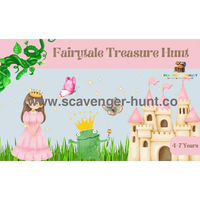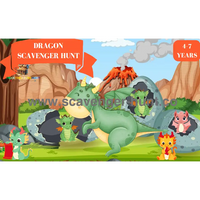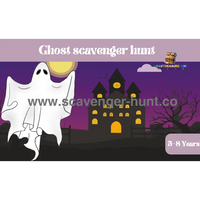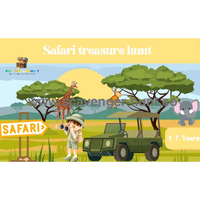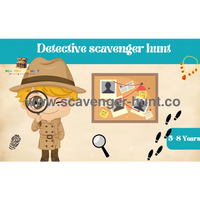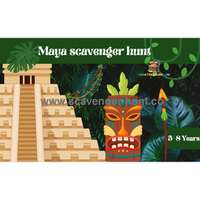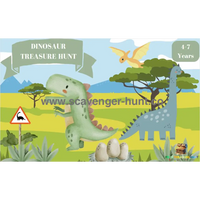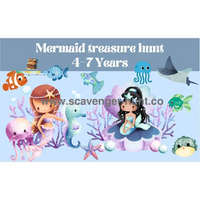🌧️Rainy Day Adventures: Indoor Treasure Hunt Ideas for Kids
Mastering The Art Of The Indoor Scavenger Hunt For Rainy Weather Fun
Rainy days can transform an ordinary weekend into an extraordinary adventure with a little creativity and imagination. Indoor treasure hunts and scavenger hunts provide the perfect opportunity for children aged 4 to 12 to explore, learn, and have fun without stepping outside. This guide will take you through setting up an unforgettable treasure hunt in your house, tailored for those dreary rainy days. From hidden clues to the final treasure, we'll cover everything you need to create a magical experience that sparks joy and excitement in young explorers. Engage your children's sense of adventure and curiosity with a well-planned indoor scavenger hunt that promises laughter and surprises around every corner.
Discover our Complete Scavenger Hunts Collection.

Planning Your Indoor Treasure Hunt
Crafting the Perfect Clues
-
Simple Riddles: For younger children, use picture clues or simple riddles that lead to easily identifiable objects around the house.
-
Creative Puzzles: Older kids will enjoy the challenge of more complex puzzles or codes that need to be deciphered.
Selecting Your Treasure
-
Rewards: Choose treasures that excite, such as small toys, books, or a special treat. Consider a final treasure chest filled with goodies for everyone to share.
An indoor treasure hunt is an excellent way to transform an ordinary day into an extraordinary adventure, especially on days when the weather keeps everyone indoors. The key to a successful treasure hunt lies in meticulous planning, from crafting engaging clues to selecting enticing treasures that captivate the imaginations of young explorers. Here's how to plan your indoor treasure hunt to ensure it's a hit with kids of all ages.
Crafting the Perfect Clues
The heart of any treasure hunt is the clues. They need to strike the perfect balance between being challenging enough to keep the kids engaged but not so difficult that they become frustrated. Here’s how to tailor your clues to different age groups:
-
Simple Riddles: Younger children, who are just beginning to explore the world around them, respond well to visual aids and straightforward tasks. Utilizing picture clues that depict the next location or simple riddles that hint at everyday objects around the house can make the hunt exciting yet manageable for them. For example, a picture of a couch could lead them to look under the cushions, or a simple riddle could guide them to the cookie jar in the kitchen.
-
Creative Puzzles: For older children who crave more of a challenge, consider incorporating complex puzzles or cryptic codes into your treasure hunt. These could involve solving a math problem that leads to a specific page in a book where the next clue is hidden or deciphering a code written in invisible ink. These types of clues not only make the hunt more thrilling but also stimulate critical thinking and problem-solving skills.
Selecting Your Treasure
The promise of treasure is what propels the young hunters forward with anticipation. Choosing the right treasure is crucial to the hunt’s success:
-
Rewards: The treasure at the end of the hunt should reflect the interests and ages of the participants. Small toys, favorite books, or special treats can serve as excellent rewards. For a group of children, consider having a final treasure chest that's filled with a variety of goodies so that everyone gets to share in the bounty. This could include an assortment of candies, small toys, and personalized notes of encouragement or congratulations for completing the hunt.
-
The Final Chest: The culmination of the hunt should be a treasure chest, real or improvised, that’s brimming with the chosen rewards. This not only provides a satisfying conclusion to the adventure but also creates a memorable moment of discovery. The chest itself can be a decorated box, a hidden drawer, or any container that adds to the excitement of uncovering the treasures within.
In planning your indoor treasure hunt, remember that the ultimate goal is to create an enjoyable and memorable experience for the children. The clues should be engaging and the treasures appealing, tailored to the participants' ages and interests. With careful planning and a touch of creativity, you can turn a simple indoor activity into an adventure of discovery and delight that the kids will talk about long after the hunt is over.
Discover our Complete Scavenger Hunts Collection.


Setting the Scene
Creating an Atmosphere
-
Theme: Pick a theme to make the hunt more engaging. Pirates, detectives, and space explorers are popular among kids.
-
Decorations: Use simple decorations to transform your home according to the theme, enhancing the adventure.
Rainy Day Challenges
Making It Educational
-
Learning Opportunities: Incorporate educational elements into the clues. For example, a clue that requires counting or identifying shapes adds a learning dimension to the fun.
Safety First
-
Indoor Safety: Ensure the hunt area is safe for all ages. Remove any potential hazards and make sure areas are well-lit.
Rainy days provide a unique opportunity to bring the adventure indoors, transforming your home into a thrilling treasure hunt landscape. However, these indoor escapades come with their own set of challenges, particularly when it comes to keeping them both educational and safe. This guide delves into how to overcome these challenges, ensuring that your indoor treasure hunt not only entertains but also enriches and protects young explorers.
Making It Educational
One of the silver linings of hosting an indoor treasure hunt is the seamless integration of educational elements into the fun and excitement. By thoughtfully designing clues that encourage learning, you can turn a day stuck indoors into a valuable educational experience. Here’s how to weave learning opportunities into the fabric of your adventure:
-
Incorporate Academic Skills: Design clues that require the use of academic skills like reading, math, and problem-solving. For example, a clue might involve reading a simple passage to discover the next location or solving a basic math problem to unlock a code. This not only keeps the hunt engaging but also reinforces important educational concepts.
-
Explore Shapes and Colors: For younger participants, clues can focus on identifying shapes and colors around the house. This can be as simple as "Find something round and red" or "Look under the square blue rug." These clues encourage observational skills and help children make connections between abstract concepts and the real world.
-
Cultural and Historical References: For a more thematic approach, include clues that reference different cultures, historical facts, or scientific concepts. This not only adds depth to the treasure hunt but also sparks curiosity about the world beyond the walls of the home.
-
Creative Thinking and Imagination: Encourage creative thinking by including riddles or puzzles that require imaginative solutions. This fosters creativity and flexible thinking, skills that are invaluable both in and out of academic settings.
Ensuring Indoor Safety
While the educational aspect of a treasure hunt is crucial, the safety of the participants is paramount. An indoor environment, while controlled, can still present hazards that need to be addressed to ensure a safe hunting experience.
-
Conduct a Safety Sweep: Before the hunt begins, conduct a thorough inspection of the areas where the treasure hunt will take place. Look for potential hazards such as sharp objects, tripping risks, or anything that could pose a danger to excited, rushing children.
-
Well-lit Areas: Make sure all areas involved in the hunt are well-lit to prevent accidents. This is especially important in spots that might not usually receive much attention, like closets or corners.
-
Age-Appropriate Challenges: Tailor the difficulty and physical requirements of the clues to the age group participating. Ensure that any tasks requiring climbing or reaching high places are adjusted or supervised to prevent falls.
-
Clear Pathways: Arrange furniture and decorations to create clear pathways for the hunters. This reduces the risk of bumps and falls as children move excitedly from clue to clue.
-
Emergency Preparations: Although it’s unlikely that anything will go wrong, it’s always wise to be prepared. Ensure that all adults present know the location of first aid supplies and have a clear plan in case of an emergency.
By focusing on both the educational content and the safety of the indoor environment, you can create a treasure hunt that not only captivates the imagination of young explorers but also offers a rich learning experience and peace of mind for everyone involved. An indoor treasure hunt on a rainy day becomes not just a way to pass the time, but a memorable adventure that educates, entertains, and safeguards the participants.
Discover our Complete Scavenger Hunts Collection.


Teamwork and Solo Adventures
Encouraging Teamwork
-
Groups: For larger families, consider dividing children into teams. This promotes collaboration and problem-solving skills.
Solo Explorers
-
Individual Challenges: For an only child, tailor the hunt to challenge their individual skills, providing hints and encouragement along the way.
Keeping the Fun Going
Reusable Ideas
-
Change It Up: Keep the game fresh by changing themes, clues, and treasures for future hunts. Introduce new challenges to keep children engaged.
Creating an indoor treasure or scavenger hunt is an excellent way to bring excitement and joy into the home, particularly on days when outdoor activities aren't feasible. However, the key to maintaining this excitement is to ensure that each hunt feels like a new adventure. This is where the concept of "Keeping the Fun Going" comes into play, focusing on the importance of rejuvenating the game with fresh ideas, themes, and challenges. Here’s how to ensure your treasure hunts remain a source of endless fun and engagement for children.
Reusable Ideas: The Art of Reinvention
The magic of a treasure hunt lies in its ability to transform the familiar into the realm of the extraordinary. By infusing each hunt with new themes, clues, and treasures, you can create a seemingly infinite series of adventures that captivate the imaginations of young participants. Here are strategies for keeping the game fresh and engaging:
-
Change It Up: The easiest way to rejuvenate a treasure hunt is to introduce new themes. Whether it’s pirates searching for buried treasure one week or detectives solving a mystery the next, changing the theme can completely alter the feel of the hunt. Themes can be inspired by children’s interests, books they’re reading, or subjects they’re learning about in school, making each hunt not only fun but also personally meaningful.
-
Innovative Clues: Along with new themes, developing new clues that match these themes can keep children on their toes. For instance, if the theme is centered around space exploration, clues could involve solving puzzles that reveal planets or star constellations. Incorporating technology, like using QR codes or simple apps, can also add a modern twist to finding the next clue.
-
Treasure Variations: The treasures at the end of the hunt should evolve with the themes. If the theme is underwater adventure, consider small aquatic toys or books about marine life as part of the treasure. For a detective theme, magnifying glasses or detective badges could serve as the coveted prize. This not only keeps the rewards interesting but also ties them back to the educational elements of the theme.
-
Introduce New Challenges: To keep older children engaged, introduce new challenges that require a bit more thought or physical activity. This could include clues that lead to mini-games or tasks they need to complete to receive the next clue. Challenges could be tailored to teach specific skills or concepts, adding an educational layer to the fun.
-
Feedback and Co-creation: Involve kids in the planning process for future hunts. Their feedback on what they enjoyed or found challenging can provide valuable insights into how to shape the next adventure. Moreover, allowing them to contribute ideas for themes or clues not only makes the hunts more engaging for them but also fosters a sense of ownership and creativity.
A Legacy of Adventure
By embracing change and continuously seeking ways to innovate, you can ensure that indoor treasure hunts remain a beloved activity in your household. The effort put into keeping the game fresh will not only provide endless entertainment for kids but also create lasting memories of joy, discovery, and family bonding. Remember, the true treasure lies in the shared experience and the journey of adventure itself, making every hunt a valuable addition to the tapestry of childhood.
Discover our Complete Scavenger Hunts Collection.


Frequently Asked Questions
1. How do I make a treasure hunt exciting for different age groups?
Tailor the complexity of the clues and the appeal of the treasures to match the age and interests of the participants.
2. Can indoor scavenger hunts be educational?
Absolutely! Incorporate puzzles that cover math, reading, or science concepts relevant to their learning levels.
3. How long should an indoor treasure hunt last?
Aim for 30 minutes to an hour, depending on the children's ages and the number of clues.
4. What if a child struggles with a clue?
Provide hints that guide them towards the solution, ensuring the game remains fun and encouraging.
5. How can I ensure the safety of an indoor scavenger hunt?
Conduct a safety check of the hunt area, removing any potential hazards and ensuring spaces are well-lit and accessible.
Discover our Complete Scavenger Hunts Collection.


Summary
An indoor treasure hunt or scavenger hunt is a fantastic way to turn a rainy day into an exciting adventure for children. By carefully planning the clues, treasure, and ensuring the activity is age-appropriate, you can create an unforgettable experience that not only entertains but also educates. Remember, the true treasure lies in the joy and memories created during the hunt. So, set the stage for an epic indoor adventure that your young explorers will treasure for years to come, proving that a little rain can't dampen the spirit of adventure.
An indoor treasure hunt or scavenger hunt stands out as a brilliant strategy to convert the gloom of rainy days into a thrilling escapade, filled with laughter and learning. This engaging activity, perfectly suited for kids of all ages, offers a unique blend of entertainment and education, all within the cozy confines of your home. By meticulously orchestrating every aspect of the hunt—from crafting ingeniously clever clues to selecting the perfect treasure and ensuring the activities resonate with the age group—you lay the groundwork for an experience that's both delightful and enlightening.
Crafting Ingenious Clues
The foundation of an enthralling treasure hunt lies in its clues. Designing clues that are both challenging and age-appropriate requires a delicate balance. For younger children, visual clues or riddles that involve everyday objects around the house can spark excitement and encourage critical thinking. Older children, on the other hand, might relish the opportunity to solve more complex puzzles or decipher codes. The key is to tailor the difficulty level to ensure it's engaging yet not overly frustrating, fostering a sense of achievement as they move from one clue to the next.
Selecting the Perfect Treasure
The anticipation of discovering treasure is what propels young adventurers forward. Therefore, choosing treasures that captivate and reward their efforts is crucial. Whether it's small toys for individual achievements or a shared treasure chest for group endeavors, the selected rewards should reflect the interests and ages of the participants. The unveiling of the treasure, ideally themed to match the adventure, serves as the grand finale, leaving a lasting impression and a sense of accomplishment.
Ensuring Age-Appropriate Activities
To guarantee a successful indoor adventure, activities must be carefully chosen to suit the age group of your explorers. This ensures not only their safety but also their enjoyment of the game. Activities that challenge them just enough to keep them interested without leading to frustration are ideal. This consideration helps in keeping the adventure fun and accessible for everyone involved.
The Educational Twist
An indoor treasure hunt offers more than just fun; it's a covert educational experience. Incorporating elements that require children to read, count, solve puzzles, or even learn about history or science turns the hunt into a learning adventure. This aspect of the game encourages children to apply their knowledge and problem-solving skills in a fun, engaging setting, reinforcing their learning in a memorable way.
Creating Lasting Memories
Ultimately, the true value of an indoor treasure hunt lies in the joy and memories it creates. It's a chance for children to embark on an adventure, solve mysteries, and discover treasures, all while learning and laughing. By setting the stage for such an epic indoor adventure, you demonstrate that a little rain cannot quell the spirit of exploration and imagination. These are the moments that children—and indeed, the whole family—will cherish for years to come, long after the rain has stopped and the sun has returned.
In conclusion, an indoor treasure hunt is a remarkable way to transform a dreary, rainy day into a vibrant adventure full of discovery and learning. With thoughtful planning and a dash of creativity, you can create an experience that entertains, educates, and endears, proving that the greatest treasures are often found not just at the map's X but in the laughter, teamwork, and memories forged along the way.
Discover our complete Would You Rather Questions collection.
Discover our Complete Scavenger Hunts Collection.





























